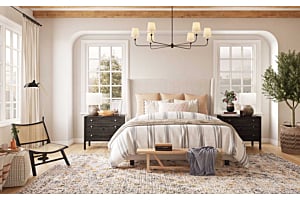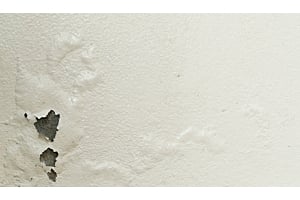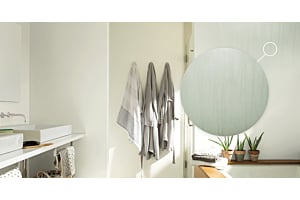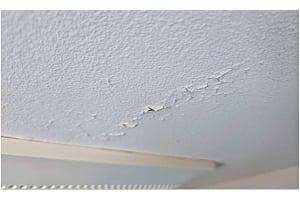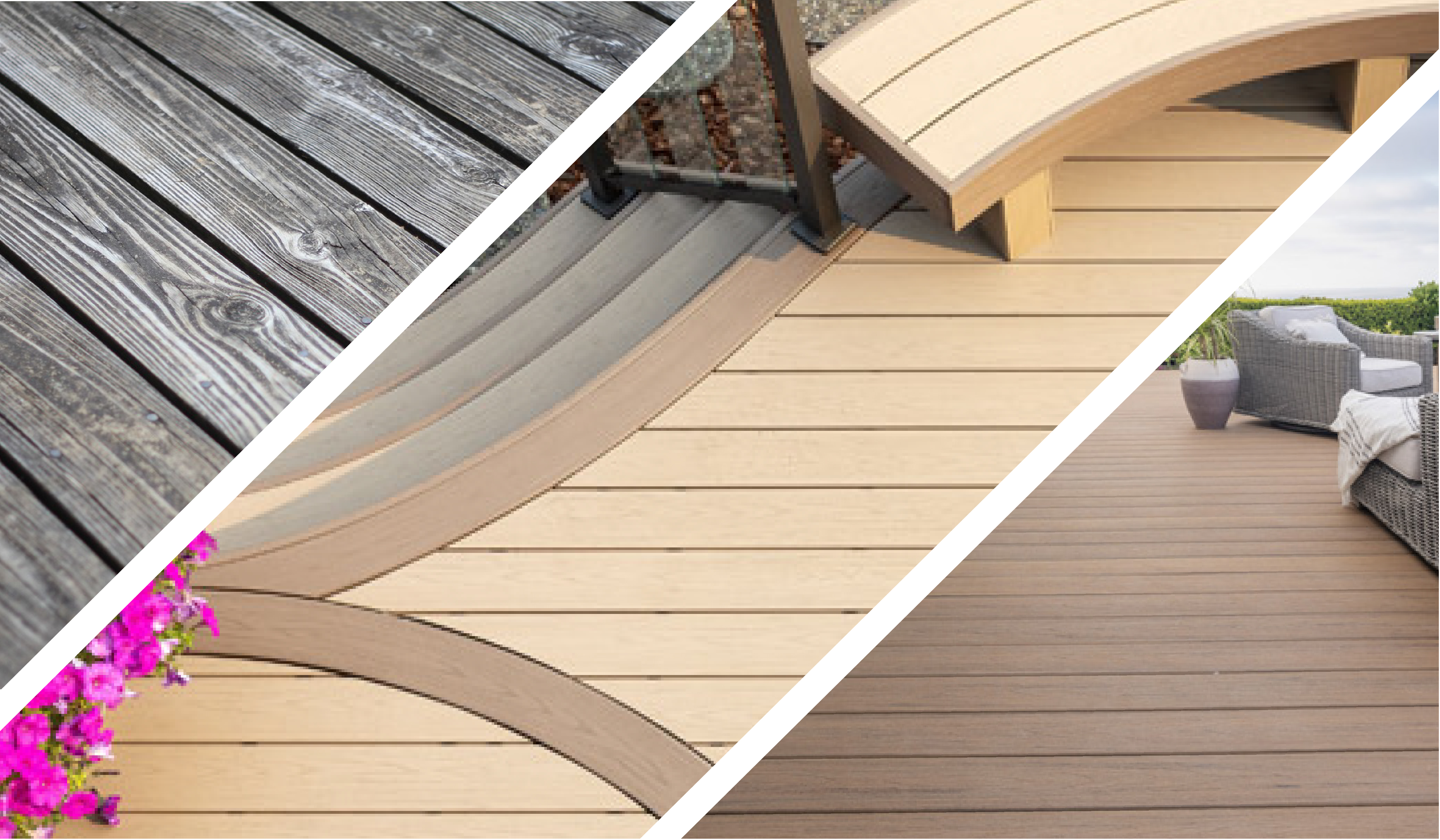
Whether you’re building a new deck or renovating an existing one, the material you choose makes a big difference in the deck’s appearance and lifespan. With so many deck options available, there’s a lot to consider when designing your new deck. Homeowners often prioritize the price of materials when shopping; but it’s also important to think about your environment, the maintenance required over the life of the deck, and the deck material’s lifespan.
A new deck is an investment in your home, so it’s smart to find the decking material that suits your budget and lifestyle. In this guide, we’ll delve into the pros and cons of the most common types of decking materials so you can create a deck design you’ll love.
Three Types of Deck Materials
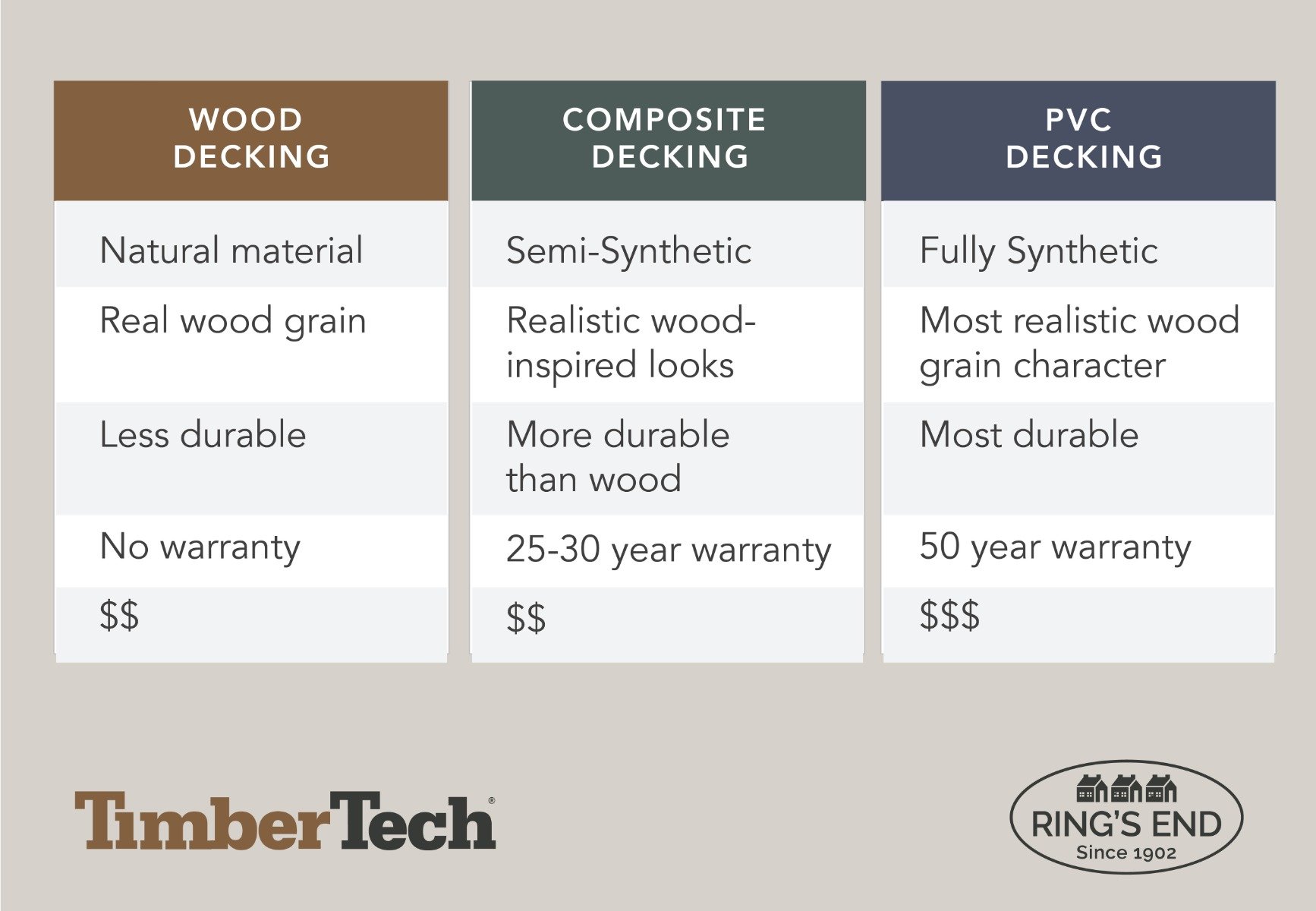
While wood decking has its place, today’s engineered materials offer an impressive selection of realistic wood grains, plus colors that are cooler to the touch. Modern composite decking materials and PVC decking may cost more initially than real wood, but they last longer and are very low-maintenance.
Wood Decking
Wood was the most popular decking material for many years because it’s a readily available, affordable decking material. However, wood is vulnerable to rot, insect damage, and surface weathering, so a wood deck requires regular maintenance. Different types of wood decking vary in price per square foot and durability. While the up-front cost of wood decking may be slightly lower than engineered materials, maintenance costs will be higher. A real wood deck typically has a 10-20 year lifespan, depending on the climate and whether it is regularly maintained.
Pressure-Treated Wood:
The least expensive wood deck option, pressure-treated wood decking infuses less dense, lower-grade wood with chemicals to seal it and deter insects. This popular deck project material is readily available at big-box retailers. Pressure-treating gives the wood a longer lifespan than just stain or sealant alone. However, because wood is an organic material, it’s still vulnerable to insects and moisture damage and will warp and splinter over time. Pressure-treated wood has the highest maintenance costs of any decking material.
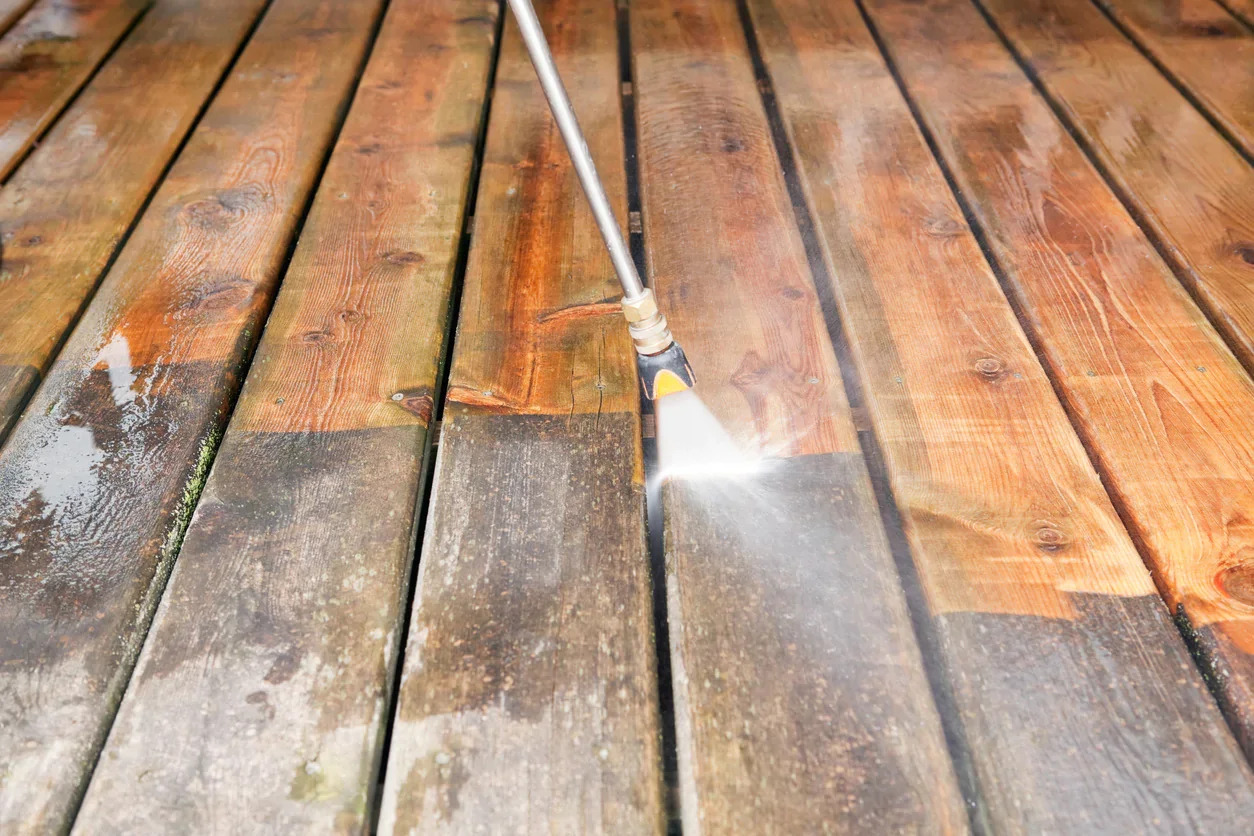 Maintenance including pressure washing is needed to fight mildew and discoloration on wood decking
Maintenance including pressure washing is needed to fight mildew and discoloration on wood decking
Hardwood & Softwood:
Wood decking materials also include exotic hardwoods like ipe, mahogany, and teak. These wood species are the ideal choice for homeowners who want the beauty of natural wood with its rich color and grain. When properly sealed and maintained, these tropical woods can stand up to the elements for years. Softwoods include cedar and redwood decking, which create a rustic look and provide beautiful color. However, real wood will fade and turn gray from exposure to UV rays; insects are always an issue. Tropical hardwood species are a more expensive option than pressure-treated lumber, and some types are even pricier than engineered materials like composite decking.
In harsh climates like the Northeast, real wood decking is not the best choice for several reasons:
- Maintenance: For proper maintenance, a real wood deck will need sealer every 1-3 years, and sanding and refinishing every 2-5 years.
- Cost: With the rising price of lumber, the cost of a high-quality wood deck is now comparable to some composite products.
- Not eco-friendly: Wood is not a sustainable decking material because it requires a continuous supply of trees. And hardwoods are not grown on tree farms – they must be cut from forests.
Composite Wood Decking
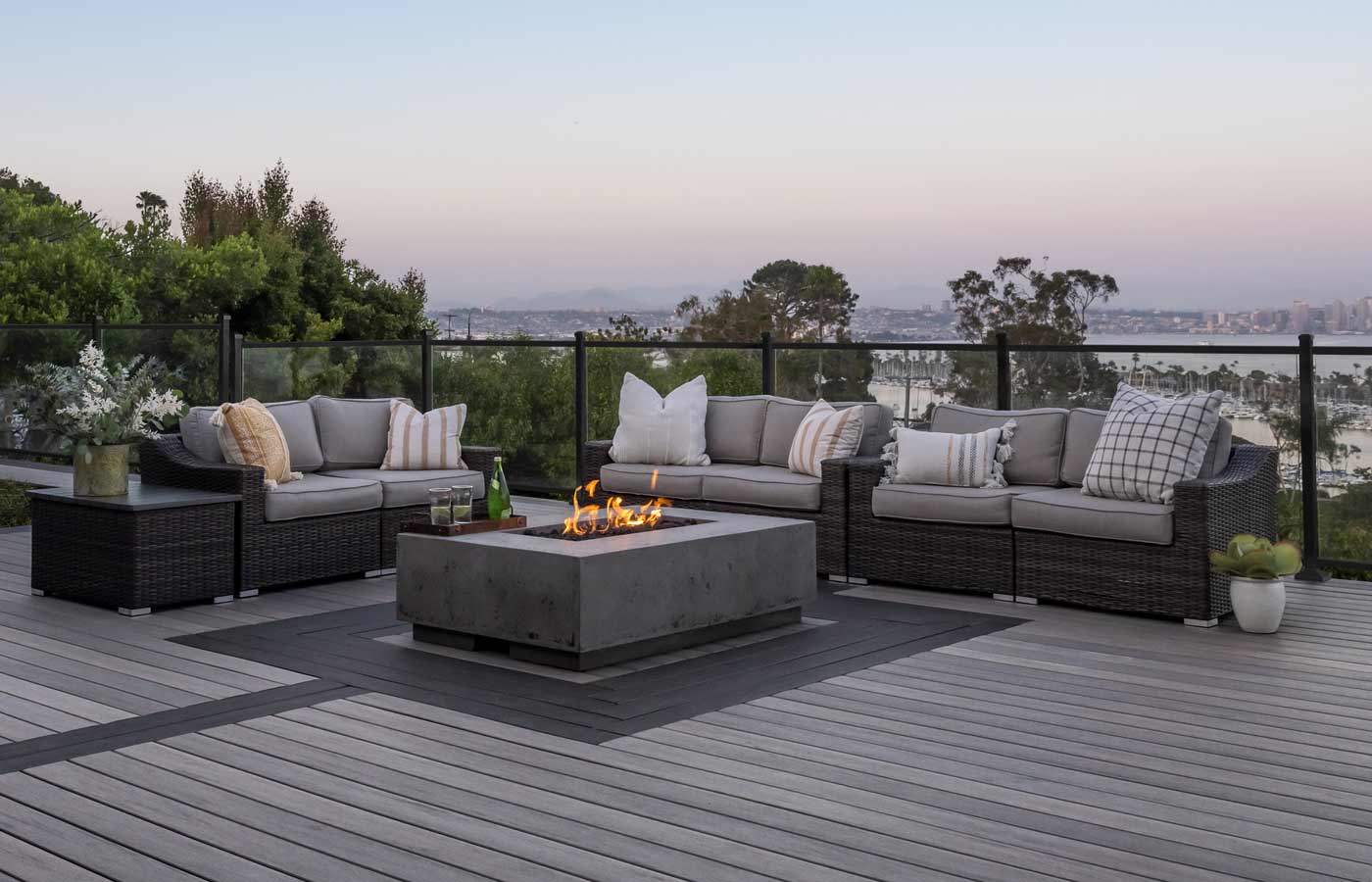 TimberTech Composite by AZEK decking in Ashwood and Espresso
TimberTech Composite by AZEK decking in Ashwood and Espresso
Composite decking is a durable, low-maintenance, and eco-friendly product. Because composite deck boards are made from a combination of wood fibers and recycled polymers, they are insect-proof and moisture-resistant. High-quality deck boards such as TimberTech Composite also have a synthetic polymer cap to seal out rain and moisture.
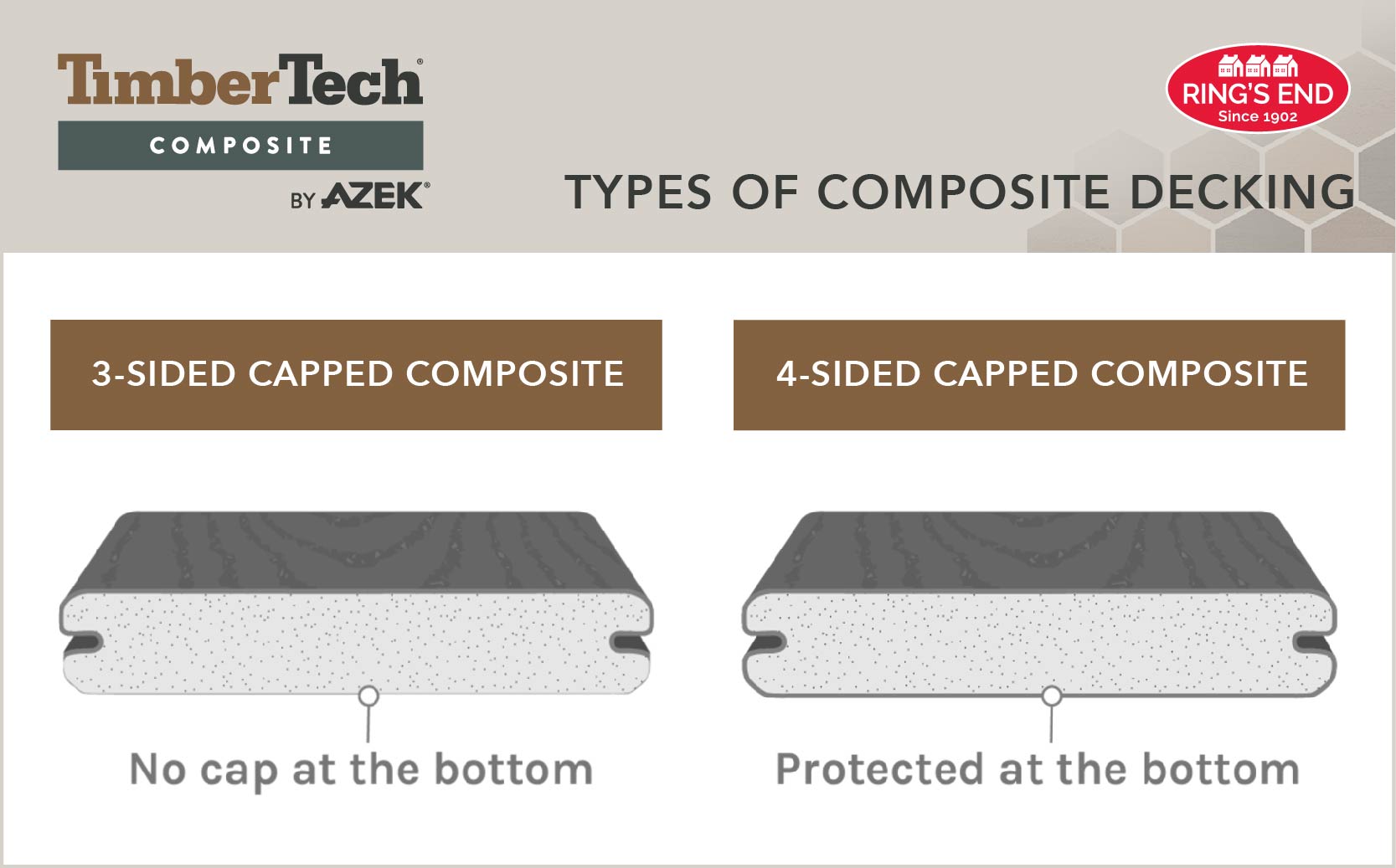
One of the biggest advantages of composite decking is that it’s very low maintenance. Because it’s an engineered material it never needs sanding or sealing. Pressure washing or scrubbing once or twice a year is all that’s needed to keep it looking beautiful. Additionally, it has a lifespan of up to 30 years. Composite decking has become tremendously popular in recent years because of its wood-like appearance and superior performance:
- Moisture-resistant and mold-proof when fully capped and protected by TimberTech’s high-performance Mold-Guard technology
- Highly slip-resistant, making it a good choice for pool areas or rainy locations
- Wide range of nature-inspired color options, surface textures, and grain patterns
- Heat-resistant and engineered with protection from UV rays
- Long-term cost-effectiveness given longer lifespan and low maintenance costs
Best Decking For Low Maintenance
PVC Decking
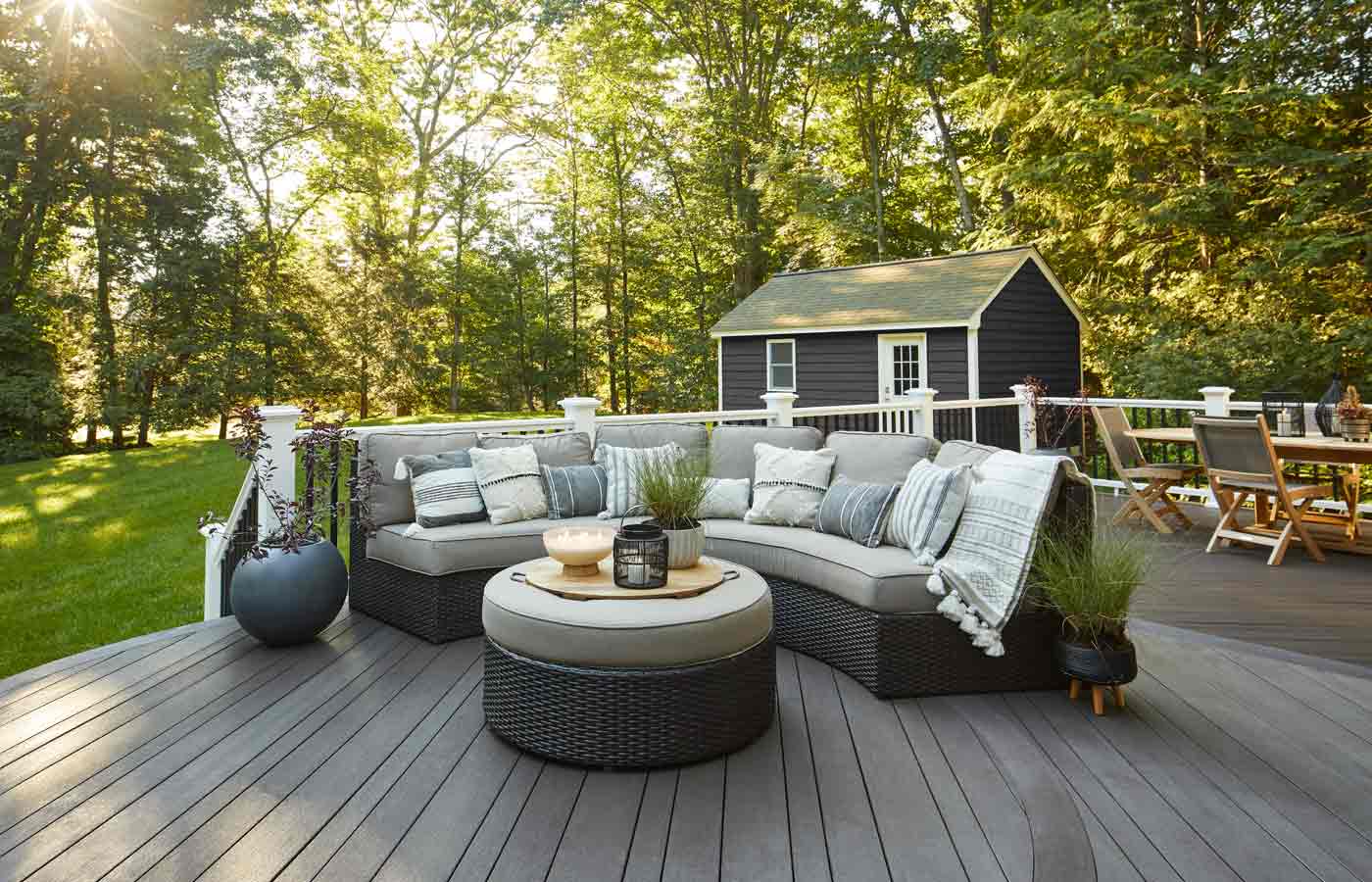 TimberTech Advanced PVC by AZEK Vintage Collection in Dark Hickory
TimberTech Advanced PVC by AZEK Vintage Collection in Dark Hickory
PVC or polyvinyl chloride decking is also an engineered product. TimberTech’s Advanced PVC decking line combines 50% recycled plastics and 50% new polymers to produce durable PVC deck boards. Like composite decking, PVC decking is low maintenance and mold-resistant. It’s also completely impervious to insects. Since the polymers can be produced in a wide range of colors, PVC decking offers the most realistic wood looks. Wire-brushed and hand-scraped patterns add to the natural appearance, and provide slip-resistance for safety. Light colors that reflect heat make PVC decking the coolest on bare feet.
Like composite decking, PVC is very low maintenance; just clean it once or twice a year. A PVC deck will never need sanding, staining, or painting, and it has a lifespan of 50 years. This eco-friendly product can even be recycled at the end of its life. While PVC is the most costly engineered decking, it also provides the greatest benefits:
- Longest lasting lifespan, with TimberTech offering a 50-year warranty
- Moisture, mold, and insect-proof; never worry about rot or termites again
- Polymer cap adds extra protection from UV rays
- Weighs less than wood or composite decking, making it manageable to transport and install for DIY projects
- 100% recyclable; deck boards can be recycled into new decking material, so it’s a very sustainable product
- Cooler in summer than many composite decking products and natural wood
- More slip-resistant than real wood
- More realistic colors, surface textures, and grain patterns than other engineered wood products.
What is the best material to use for your deck?
Choosing the right decking for your outdoor space will always be a matter of budget and design preferences. In the past, the much lower cost of wood gave it a clear advantage over engineered products like composite and PVC. However, a drastic increase in wood prices has closed that gap. Plus, when you calculate the cost of upkeep for a wood deck over time, a deck made from synthetic materials is the smart choice.
Both PVC and composite decking are durable, low maintenance, cost-effective, and insect-proof. They’re available in a wide range of colors with surface textures that create beautiful, realistic wood looks. Both products offer matching railings for a cohesive deck design. Plus, engineered decking is substantially more eco-friendly than a traditional wood deck.
The color of your home and your deck’s location will also influence your choice of materials. For example, if your yard is shady and wooded, a darker color will blend with the landscape. If you have a pool, a light color will provide a cooler surface on bare feet. Whatever you decide, it’s important to take your time; your new deck will be a lasting feature of your home.
Explore TimberTech Decking at Ring’s End
Need help making your dream deck a reality? Ring’s End offers TimberTech products because we know that homeowners have confidence in their quality and industry-leading warranty. You’ll also love the extensive color and design options TimberTech offers. Check out our guide to Choosing the Best TimberTech Color For Your Deck to learn more about creating a deck that’s right for your home.
Discover 25 Nature-Inspired Decking Colors That Never Fade
Remember we’re here to help! Whether online or in-store, our Ring’s End experts want to help you understand your options and guide you to the best products for your decking project. To learn more about TimberTech’s decking options, check out our product guide or reach out to one of our expert sales representatives through our chat! You can also visit a Ring’s End store near you for free color samples and professional help with planning, pricing, and delivery.


